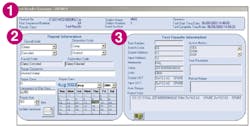Statistical Analysis for Automated Wire Test Operations
The U.S. Coast Guard launches a search to collect wiring failure data and makes sense of the data once it is captured.
Industries such as aircraft, aerospace, telecommunications, and transportation have long recognized automated testing of electrical and fiber-optic systems as the optimal way to ensure the integrity of complex, critical systems. Automated test programming and execution quickly and consistently identify opens, shorts, and other wiring or fiber fabrication problems in cables, harnesses, subassemblies, and final products.
The Aircraft Repair and Supply Center (ARSC) in Elizabeth City, NC, provides depot-level maintenance and overhaul operations for HH-65, HH-60, HU-25, and HC-130 aircraft (see sidebar). Just as the ARSC continually investigates ways to improve the overall electrical reliability of Coast Guard aircraft, it also looks for opportunities to reduce repair costs and cycle time within the aviation depot facility. This objective prompted the ARSC�s wiring program management to explore a way to collect wiring failure data from multiple aircraft and make sense of the data once it was captured.
U.S. Coast Guard maintenance operations have used automated wiring analyzers to test aircraft during the overhaul process for many years. The depot services several Coast Guard aircraft, including helicopters used for rescue and recovery operations as well as rotary and fixed-wing aircraft for surveillance, transport, and other missions related to national security.
Test operators could successfully locate shorts and opens. However, once tests and repairs were complete, there was no way to easily collect and track wiring failures and associated repairs for multiple aircraft.
The ARSC addressed this problem by implementing TestStats�, a DIT-MCO software package that creates a database, performs statistical analysis of test data from multiple aircraft, and provides tools that generate reports for engineering and management. The HH-65 Dolphin Search and Rescue Helicopter is the first to be tested using the new software.
By systematically collecting and analyzing metrics related to electrical failures, repair types, repair time, aircraft zone, and aircraft tail number, the Coast Guard is tracking information that helps identify recurring failures and locate the root cause of failures, a prerequisite for preventing future failures. Once the cause is understood, then the ARSC can address possible solutions such as training opportunities, tooling changes, or design adaptations.
Preventing discrete wiring failures, or proactive testing, translates into saving time, not only in the electrical shop, but also throughout the complete overhaul cycle; reducing costs; increasing reliability of aircraft electrical systems; and forecasting staffing requirements, training needs, and aircraft repair times.
Overhauling Helicopters
By definition, Coast Guard equipment operates in a corrosive environment. Systems inside and outside an aircraft are routinely exposed to saltwater, which takes a heavy toll.
The first stage of the overhaul process for the HH-65 helicopter or any Coast Guard aircraft is teardown. Depot personnel strip down the cockpit and airframe and remove avionics and other assemblies and systems.
Technicians install new modules, including electrical and electronic components, and upgrade wiring through a build-up phase. Electrical test occurs after the electrical build-up and engineering modifications are completed and before the avionics are reinstalled.
The ARSC uses a DIT-MCO Model 2524 Automated Wiring Analyzer to ensure correct wiring configuration. Test operators run eight continuity and resistance tests to verify that airframe, avionics, and re-engine work and upgrade wiring is configured properly.
The operators must test, find the fault, repair the fault, and continue testing until a 100% pass rate is achieved. In the past, the electrical testing stage was complete at this point. Implementing TestStats involves one more step.
Building a Database
Statistical analysis requires a body of data to work with. TestStats constructs the database by integrating automatic data captures with user-entered data. Every time a test is run, the TestExecutive� software records the data and displays test results to the operator, indicating opens, shorts, and any other failure data generated during the test.
In traditional test operations, test data for any given product under test is not used again. But with the ARSC�s new process, TestExecutive captures and stores the data from the testing process for future analysis. It accomplishes this via the component object model (COM) software architecture.
When the test operator has repaired any faults and achieved an error-free test, the next step is to review the failure data and add details to give a comprehensive description of each failure and its resolution.
This additional level of detail allows the basic data to be further analyzed and used to understand failures for a whole group of aircraft, identify trends, and make forecasts. Having this information at hand enables the ARSC to learn what is causing failures, where they are occurring, what components are involved, and what repairs are required.
The User Data Entry Task
Operators perform data entry using a graphical user interface. The test results summary screen (Figure 1) has three panes:
1. Product File: Displays information about the selected test sequence number including data such as product file name, results type, station number, operator ID, serial number, and test start and completion times/dates.
2. Repair Information: Provides pull-down menus, numeric fields, and text-entry fields for data entry of causal code, disposition code, repair comments, aircraft zones, repair date, component ID, and repair time.
3. Test Results Information: Displays information about the test and the specific wire or connection, such as test number, switch code, output/input address of the wire, measured value, units, input/output of the unit under test, active modes, test parameters, and picked relays.
Causal Code is a noun-verb phrase that indicates the condition responsible for a test result. The technician selects the component from one drop-down list and the problem from a second list (Table 1).
Similarly, Disposition Code indicates what action was taken to fix the failure. The technician selects a component from the first drop-down list and the repair from a second list (Table 2).
The ARSC identified 17 electrical zones on the HH-65 to distinguish areas of the aircraft by wiring rather than physical structure. The repair zones include the nose compartment, instrument panel, cabin, baggage compartment, several alpha panels, the tail cone/fenestron, and the avionics rack.
As more aircraft are tested, the database grows accordingly. To drill down even farther, the ARSC plans to expand the type of data collected to include information such as wire number, connector number, and component number.
Exporting the Data
When the data collection in TestStats is complete, a test engineer exports the data to Microsoft Excel. Within Excel, the data can be sorted, trended, inserted into statistical formulas, reported, and charted as extensively as desired. Excel provides some basic statistical operations, and the TestStats software package includes templates to generate basic statistics and charts, such as standard deviation and distribution charts.
Based on this analysis, engineering and management might determine that electrical design modifications are required or identify other opportunities for improvement, such as enhancements to tooling, training, or documentation.
Analyzing test data from nine HH-65 aircraft revealed the following:
� Location of Wiring Failures: More wiring failures occur in the avionics rack/CB panel zone than any other electrical zone on the aircraft.
� Most Common Failures: The most common failure type was connector wired wrong (Figure 2). The center has been able to link this to the ongoing re-engining and upgrade efforts. The second most frequent failure is caused by a corroded connector.
� Average Number of Failures per Aircraft: 86
� Average Time for Repair of Each Aircraft: 42.5 hours
The ARSC tests three or four HH-65 aircraft per month. The ongoing analysis is giving the Coast Guard data it can use to make changes in several ways:
� The ARSC will focus more attention on the avionics rack zone of HH-65s during upgrades and depot maintenance including increasing inspection activities or enhancing inspection procedures.
� In the case of connectors being wired wrong during depot maintenance, the ARSC is looking at possible changes in training or wiring manuals; for example, documentation may not be up to date.
� Noting that corroded connectors are the second highest failure type, more analysis revealed that the majority of these failures were located in the wheel well and tail cone zones. This information will help maintenance personnel better understand where corrosion inspections and better prevention must be performed.
� By examining the total repair time for each aircraft, the ARSC will have the information it needs to improve its planning for aircraft depot repair time and staffing requirements.
Based on the outcome from the first few months of the implementation, the Coast Guard plans to expand the use of TestStats to collect and track aircraft wiring failure data for three other aircraft. The ARSC will use the same set of causal and disposition codes and modify the aircraft zone designations.
The ARSC
The ARSC is the U.S. Coast Guard�s only aviation industrial support facility and specializes in overhaul production, technical support, supply chain management, and data warehousing and information technology. The center recently started overhauling and supporting U.S. Air Force Special Operations HH-60 Aircraft and has an opportunity to modify the new aircraft that are being procured through the Deepwater Contract, a multiyear project to modernize the Coast Guard�s aging ships, aircraft, command and control, and logistics systems.The Coast Guard�s HH-65 Dolphin is a short-range recovery helicopter. The twin-engine aircraft operates up to 150 miles offshore and assists in the missions of search and rescue, enforcement of laws and treaties including drug interdiction, polar icebreaking, marine environmental protection such as pollution control, and military readiness. Helicopters stationed aboard icebreakers are the ship�s eyes to find thinner and more navigable ice channels. In addition, they airlift supplies to ships and villages isolated by winter weather.
About the Authors
Keith Stevenson is the wiring program manager in the Aging Aircraft Branch at the U.S. Coast Guard�s ARSC where he has worked for 13 years. He participates as a member of the Joint Council on Aging Aircraft and represents the Coast Guard in the Joint Service Wiring Action Group. He received a B.S. in electrical engineering from Old Dominion University. U.S. Coast Guard, ARSC Elizabeth City, NC 27909, e-mail: [email protected]
Michael Bequette, P.E., is the program manager for DIT-MCO International. He has been with the company for more than eight years and has more than 13 years of software engineering experience. He earned a B.S. in electrical engineering and a B.S. in theoretical physics from Kansas State University and an M.S. in electrical engineering. DIT-MCO International, 5612 Brighton Terrace, Kansas City, MO 64130, 800-821-3487, e-mail: [email protected]
FOR MORE INFORMATION
on statistical analysis software
www.rsleads.com/606ee-181
June 2006





